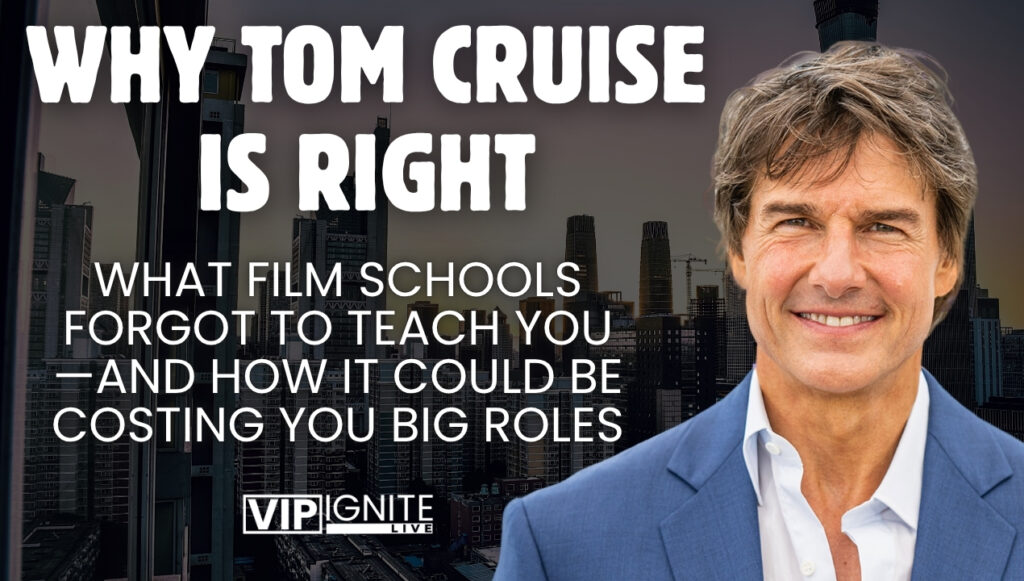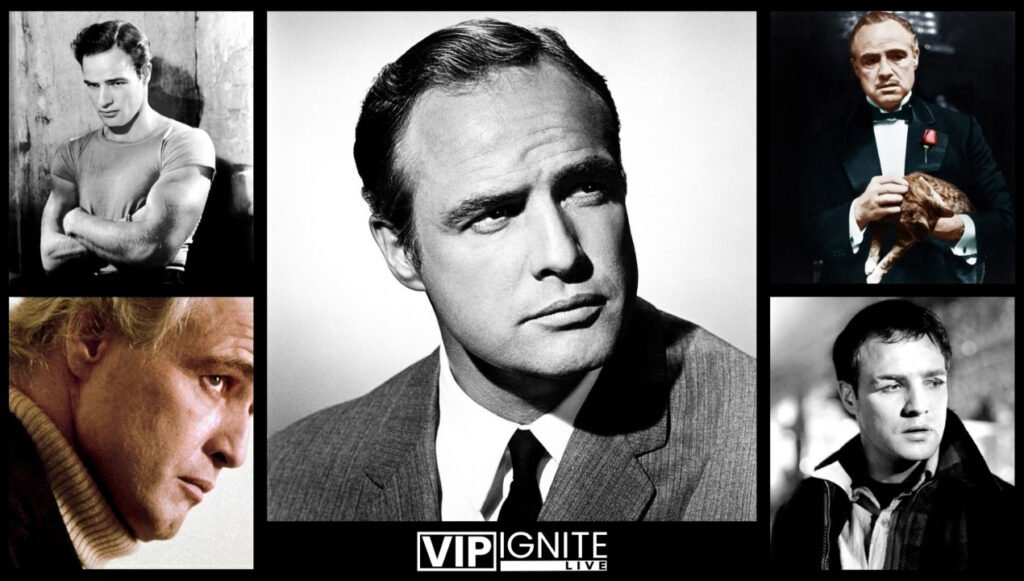
By VIP Ignite
When Tom Cruise speaks, the smart actors listen.
At a recent British Film Institute (BFI) event, Cruise dropped a truth bomb that sent ripples across the entertainment world:
“Film schools aren’t teaching actors what they really need to know about making movies.”
But he wasn’t talking about monologues or scene study.
He was talking about the technical side of filmmaking—the part most actors ignore, and most schools completely gloss over. And if you’re serious about building a lasting, respected career in film and television, this is a conversation you can’t afford to ignore.
In this article, we’re breaking down the heart of what Cruise said, examining how legends like Marlon Brando became masters of the camera, and giving you an inside look at the critical technical knowledge most actors never learn. Let’s go beyond the surface—and unlock the real skills that separate working actors from hopeful amateurs.
Tom Cruise’s Wake-Up Call to Aspiring Talent
Tom Cruise didn’t become one of the biggest stars in Hollywood by accident. Yes, he’s talented. Yes, he’s charismatic. But what makes Cruise truly exceptional is his obsession with mastering every element of the craft—not just what happens in front of the lens.
After his breakout role in Risky Business, Cruise negotiated creative control on Top Gun. That meant more than approval on lines or blocking. It meant attending every production meeting. Learning how the camera moved. Understanding why a particular lens was chosen. Sitting in editing rooms and dissecting performances frame by frame.
He didn’t do it to become a director.
He did it to become indispensable.
And that’s where most film schools fail. They teach you how to act. But they don’t teach you how to work on a set.
What Most Actors Don’t Know (That Casting Directors Wish They Did)
Let’s break down what Cruise is talking about—and why it’s so important.
Traditional actor training focuses on internal work: character development, emotional access, vocal training, and movement. All essential. But those tools don’t help you when the camera’s two feet from your face, your light is fading, and you’ve got one take to make it work.
The reality is: the camera is not your audience—the editor is. And if you don’t understand how to shape your performance for the technical environment of a set, you’ll never be truly effective in film or TV.

Here are five technical areas every actor should master:
1. Lens Awareness
Different lenses change how your face and movement appear on screen. A 24mm wide-angle lens exaggerates distance and can distort your features. A 100mm telephoto lens flattens your image and compresses space.
Actors who understand lens dynamics adjust their energy and expressions accordingly. They know how to modulate their performance for a wide shot vs. a tight close-up—and they know when subtlety will be magnified on camera.
2. Framing and Blocking for the Camera
Do you know what a “dirty single” is? What about an “over-the-shoulder” or a “cowboy shot”?
Blocking isn’t about where you feel like going—it’s about where the camera needs you to be. Professional actors hit their marks, stay in frame, and know how to deliver performance while respecting the needs of the shot. That means learning to move with purpose, pace your dialogue with camera movement, and stay within the focus range of the lens.
3. Lighting Mastery
One of the fastest ways to get called back—or never called again—is your relationship with the light.
Can you find your key light without asking? Do you know how your positioning affects shadows on your face? Are you aware of how bouncing too much light off your skin can flatten emotion?
Great actors know how to play with the light. They lean into shadows to create mystery. They shift slightly to open their eyes to the lens. They protect continuity and understand how lighting builds the tone of the story.
4. Audio and Microphone Discipline
Your dialogue might be gold—but if your lav mic is brushing against your clothing, or you keep turning away from the boom, it’s worthless.
Professional actors know how to breathe without noise. They keep their volume consistent, protect sound continuity between takes, and avoid wardrobe that interferes with mic placement. It’s not just about being heard—it’s about being usable in post.
5. Editing Awareness
Here’s something nobody tells you: the real performance often happens in the edit room.
If you don’t understand how editors work, you’re making their job harder—and yours less likely to make the final cut.
Great actors protect the edit by:
• Hitting the same marks each take
• Matching emotional intensity beat by beat
• Offering usable transitions for insert shots
• Providing coverage options that preserve story logic
When you understand how your work fits into the edit, you become a collaborator, not a liability.
The Marlon Brando Effect: Why Stillness Matters More Than You Think
Marlon Brando didn’t just act—he revolutionized how actors work on camera.
While often remembered for his emotional depth and unpredictability, Brando’s true genius was in his technical command of the frame.
In The Godfather, Brando famously stuffed his cheeks to physically shape the character of Don Corleone. But more importantly, he barely moved. He used silence as a weapon. A shift of the eyes. A tilt of the chin. A pause in breath. His stillness wasn’t passive—it was powerful.
Why did it work?
Because Brando understood something most actors overlook: the camera sees everything. A millimeter of eyebrow movement. A subtle sigh. The tension in your hands.
In a medium close-up, what feels “understated” to you can scream off the screen. Brando mastered that. So did Jack Nicholson, Robert De Niro, and yes—Tom Cruise.

Why Technical Mastery = Professional Respect
Here’s the truth most working actors know:
If you’re only thinking about your performance, you’re already behind.
Directors, DPs, and editors don’t want to babysit actors who don’t understand how to work with the tools of the craft. But when an actor shows up prepared, confident, and camera-literate?
They earn trust.
They get asked back.
They get recommended for other roles.
Technical fluency makes you more efficient, more castable, and more dangerous in the best way. It transforms you from “talent” into a full creative collaborator.
How to Train This (Without Going to Film School)
If film schools aren’t teaching this—and Tom Cruise is saying it’s essential—how do you actually learn it?
Here are a few real-world ways to begin developing technical awareness:
– Volunteer on student film sets
You’ll learn camera language just by observing. Notice how the DP frames the shots. Watch how the actors adjust to blocking. Pay attention to lighting setups between scenes.
– Shadow editors and directors
Offer to sit in on editing sessions or table reads. Watch what footage gets cut—and ask why. Editors will teach you what really reads.
– Study cinematography and camera basics
You don’t need to be a DP, but you should know the difference between a 35mm prime and a 70-200 zoom. Understand focal length, depth of field, and composition.
– Film yourself and watch critically
Use your smartphone or DSLR. Study how your facial expressions land at different distances. Play with lighting setups. Start understanding how YOU look through the lens.
– Work with photographers and on-camera coaches
Great photographers can show you how posture, breath, and subtle movement shape your on-screen presence. Treat every photoshoot as training for your next on-set gig.
The Bottom Line: Acting Is a Team Sport, Not a Solo Act
Yes, you must be emotionally compelling. Yes, you need confidence and skill.
But to truly work in this industry, you must be more than a solo artist—you must be a collaborator.
Understanding the technical craft of filmmaking—what Tom Cruise, Marlon Brando, and every great actor studies—makes you indispensable to any production team. It turns you from a “risk” into a resource. From a hopeful into a professional.
And it’s never too late to start.
Final Words (And a Preview of What’s Coming)
At VIP Ignite, we’ve spent over two decades helping models and actors go from dreamers to booked professionals. We’ve worked with talent who had no experience and are now earning six figures in campaigns for global brands.
The one thing all of our successful talent have in common?
They didn’t just rely on talent—they trained to become camera-ready collaborators.
In the weeks ahead, we’ll be sharing an opportunity to take this training further—alongside real professionals, working DPs, and top-tier mentors. It will be immersive. It will be challenging. And it will be unlike anything you’ve experienced before.
Stay tuned.
And until then…
“Know the lens. Know the light. Know the cut. Then walk onto set like you own the story.”


Recent Comments